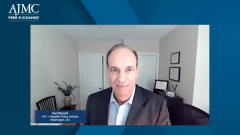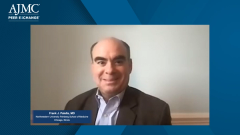
USPSTF Guidelines: Approaching Optimal Therapy for HIV PrEP
Frank J. Palella, MD, shares a provider perspective for steps to take in accordance with USPSTF guidelines for HIV PrEP to get patients appropriate medications, and Ryan Bitton, PharmD, MBA, shares a provider prospective on supporting expedited prior authorizations.
Episodes in this series

Ryan Haumschild, PharmD, MS, MBA: Hearing context around expedited transparent medical necessity, realizing that there are extra steps needed from the provider, Frank, I want to turn to you. From your personal perspective, and even from your practice, where do you push when you’re trying to follow these FAQs [frequently asked questions]? Working with your payers, as a provider, what steps do you take to get your patient on the most appropriate medication? Do you see yourself having to go through medical necessity steps and do these peer-to-peers? How hard do you push when you’re trying to follow these FAQs and roll out the best therapies for your patient?
Frank J. Palella, MD:It’s a great question. The guiding principle is risk aversion. When I’m making appeals, through peer-to-peers or other avenues with payers, I talk about risks and the need to avert them. For example, in someone for whom I might believe that tenofovir disoproxil fumarate [TDF] is inappropriate—for persons with modest renal function or who already have a propensity or evidence of some osteopenia—it is my job as advocate and protector of this patient to not contribute to or cause a medical problem by virtue of an intervention that I am giving to prevent HIV. Depicting risk aversion for a patient as an incentive is an effective device when talking to payers.
Ryan Haumschild, PharmD, MS, MBA: I like that risk-aversion piece. That’s important. When you have risk aversion—which is a great way to practice—and you have to appeal a rejection, do you find yourself doing a bunch of appeals? You mentioned that you meet with payers earlier because you want to demonstrate the value of the medication you’re selecting. In summary, do you find yourself doing a lot of appeals in the cases of rejections? What information is as appropriate to help you—I don’t want to say “win the appeal” because it’s not about winning—best advocate for your patient?
Frank J. Palella, MD:In the spirit of saying it takes a village, I practice in a place where we have full-time clinical PharmDs who are extremely pivotal in the whole appeals process, as our nurses and case managers can be. For example, if I have a person who has diabetes—which is a massively competing risk for kidney dysfunction, for example—and because the essence of the intervention for PrEP [pre-exposure prophylaxis] is preventive, I want to prevent potential adverse effects of some older forms of PrEP like TDF-based therapy. I bring to the table the context of the specific patient because every appeal is an individual case. I try not to make broader generalities and say, “TAF [tenofovir alafenamide] is going to be healthier in the long run for everybody.” Those don’t tend to fly with payers. When we talk in the context of specific patients and needs, given their preexisting conditions, competing risks, and overall health state, we can be persuasive. I hope I’m answering your question adequately.
Ryan Haumschild, PharmD, MS, MBA: Yes. I appreciate all the context you’re providing, saying you can’t take a universal approach and say this medication is better for everybody, so why aren’t you considering it? You’re trying to make it individualized to meet the needs of the patient but also understand the payer group and how to get that pushed through.
Ryan, you talked about 72 hours being a medical necessity and the expedited review. How do you support a lot of these prior authorizations for the expedited review, according to the guidance? Does it follow your expedited queue that you would use for many disease states? Do you have anything 1-off? How do you monitor to make sure you’re meeting the requirements of this guidance? I’m curious how you operationalize that.
Ryan Bitton, PharmD, MBA: It’s probably highly different between plans. You’ve got PBMs [pharmacy benefit managers] who are doing prior authorization, and you’ve got plans doing prior authorization. There are lots of differences in how that prior-authorization and exceptions-request process is working. In most worlds, you just throw it into the expedited queue. That expedited queue I referred to as 24 to 72 hours. It depends on which organization and line of business you’re looking at, but in our world, it’s easier to say, “This is expedited.” We’re not saying, “This is 24 hours. This is 72 hours.” I’m a smaller shop, so I may be different. We say, “Just get these done as fast as you can.” Other organizations may be different. That’s the approach for all expedited requests; it’s tough. We say it’s expedited, but how do you say 1 is more expedited than another? We’re not going to play that game. We do all of them quickly.
Ryan Haumschild, PharmD, MS, MBA: That’s helpful to know. I agree: how do you prioritize? This group might say that PrEP therapy is 1 of the most important compared with other things, which I totally recognize.
Transcript Edited for Clarity
Newsletter
Stay ahead of policy, cost, and value—subscribe to AJMC for expert insights at the intersection of clinical care and health economics.






























































